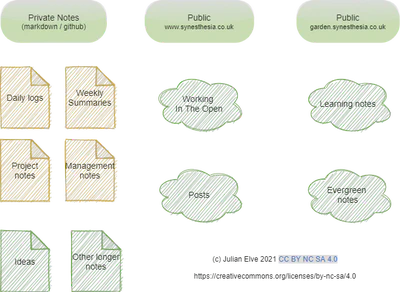This post is part of my wider enquiry into my note-making practices.
Overview
Over the years I’ve tried all sorts of methodologies for managing the ideas that flow in and out of work projects, crop up in reading, diving down rabbit holes on social media, etc.
The main things I’ve learned are to keep the technologies as simple as possible, and not to fret too much about a specific process.
Having said that, I seem to have found a set of practices which are consistent enough to give me just enough structure that I don’t have to think too hard about where something goes, as shown in the diagram.

Private / structured notes
Like most professionals the vast majority of my written output is private work product. Looking at the diagram these are the notes on the left. Within this there are structured notes (orange in the diagram) and freeform notes (green in the diagram). The structured part loosely follows some of the ideas in GTD, and are somewhat inspired by Ton Zjilstra’s post on the hierarchical part of his note-taking.
The daily logs and weekly summaries are the most structured, in the sense that I have a standard set of templated headings to prompt me and speed things up.
| Daily logs | ToDos / Activity log / daily review questions |
| Weekly summaries | Lookaheads at start of week (key priorities), review at end of week (key accomplishments, blockers, things I learned, carry forward to next week) |
The other notes are much more variable in format, driven by whatever area of work they relate to, and are arranged in folders by project or area of management concern (for example I have a folder for each member of my team where I keep notes relating to 1:1 meetings).
All of these notes are likely to link to material elsewhere e.g. documents in OneDrive / Teams, product plans in Aha!, even individual code commits.
Private / unstructured notes
Within my private unstructured (and inter-linked) notes (green, on the left) I loosely divide things into Ideas and Longer Notes. The main difference (and it’s not hard and fast) is around length and complexity.
Ideas are single concept short notes that may capture a reference that I found useful or interesting, and might be a single sentence.
I use longer notes for a range of purposes, including assembling argument and analysis around a topic before creating more formal product. Often the only thing that distinguishes these from the learning notes and evergreen notes in my public material is that because they are private I can write more freely on professional topics without taking the time to generalise or anonymise.
Public notes
Writing in public (the right side of the diagram) is something we all commit to when we start a blog, or a wiki, or a digital garden, or just about any form of self-publishing.
The most useful differentiation in my mind is between the Garden and the Stream: each has its merits.
For time-based notes, on this site I maintain a somewhat artificial distinction between two streams, Work Notes and Posts. Mostly the former are about work, the latter about anything that takes my notice, but it’s not hard and fast.
My other public notes (Garden mode) have moved homes a few times, and currently live in the Digital Garden. In the diagram I have shown two sorts of notes (Learning Notes and Evergreen Notes), but it’s a difference of what is in the note rather than anything structural.
For Evergreen Notes the aspiration that they should be concept-based, atomic, densely-linked and develop iteratively.
All of those are exacting standards, so I invented a second category of learning notes to cover everything else, but there is no formal distinction between the two. Mostly that’s about me getting comfortable with writing things which don’t “meet the standard”!
Key lessons
So far, I would give my future self just three clear instructions:
- if in doubt write - and the one to really stick to is the daily log, because everything flows from there
- don’t worry about sticking to the structure if it doesn’t work for a particular thing
- abandon any self-criticism when the stuff you write doesn’t hit the lofty goals for Evergreen notes